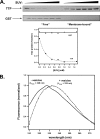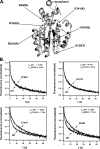Mechanisms of ligand transfer by the hepatic tocopherol transfer protein
- PMID: 18458085
- PMCID: PMC2440614
- DOI: 10.1074/jbc.M800121200
Mechanisms of ligand transfer by the hepatic tocopherol transfer protein
Abstract
alpha-Tocopherol is a member of the vitamin E family that functions as the principal fat-soluble antioxidant in vertebrates. Body-wide distribution of tocopherol is regulated by the hepatic alpha-tocopherol transfer protein (alphaTTP), which stimulates secretion of the vitamin from hepatocytes to circulating lipoproteins. This biological activity of alphaTTP is thought to stem from its ability to facilitate the transfer of vitamin E between membranes, but the mechanism by which the protein exerts this activity remains poorly understood. Using a fluorescence energy transfer methodology, we found that the rate of tocopherol transfer from lipid vesicles to alphaTTP increases with increasing alphaTTP concentration. This concentration dependence indicates that ligand transfer by alphaTTP involves direct protein-membrane interaction. In support of this notion, equilibrium analyses employing filtration, dual polarization interferometry, and tryptophan fluorescence demonstrated the presence of a stable alphaTTP-bilayer complex. The physical association of alphaTTP with membranes is markedly sensitive to the presence of vitamin E in the bilayer. Some naturally occurring mutations in alphaTTP that cause the hereditary disorder ataxia with vitamin E deficiency diminish the effect of tocopherol on the protein-membrane association, suggesting a possible mechanism for the accompanying pathology.
Figures






Similar articles
-
alpha-tocopherol transfer protein stimulates the secretion of alpha-tocopherol from a cultured liver cell line through a brefeldin A-insensitive pathway.Proc Natl Acad Sci U S A. 1997 Nov 11;94(23):12437-41. doi: 10.1073/pnas.94.23.12437. Proc Natl Acad Sci U S A. 1997. PMID: 9356467 Free PMC article.
-
Utility of a fluorescent vitamin E analogue as a probe for tocopherol transfer protein activity.Biochemistry. 2006 Jan 31;45(4):1075-81. doi: 10.1021/bi052271y. Biochemistry. 2006. PMID: 16430203 Free PMC article.
-
Affinity for alpha-tocopherol transfer protein as a determinant of the biological activities of vitamin E analogs.FEBS Lett. 1997 Jun 2;409(1):105-8. doi: 10.1016/s0014-5793(97)00499-7. FEBS Lett. 1997. PMID: 9199513
-
Dietary alpha-tocopherol and neuromuscular health: search for optimal dose and molecular mechanisms continues!Mol Nutr Food Res. 2010 May;54(5):693-709. doi: 10.1002/mnfr.200900575. Mol Nutr Food Res. 2010. PMID: 20187127 Review.
-
Tocopherol-binding proteins: their function and physiological significance.Antioxid Redox Signal. 2000 Fall;2(3):397-404. doi: 10.1089/15230860050192170. Antioxid Redox Signal. 2000. PMID: 11229353 Review.
Cited by
-
2,2'-Bis(monoacylglycero) PO4 (BMP), but Not 3,1'-BMP, increases membrane curvature stress to enhance α-tocopherol transfer protein binding to membranes.Lipids. 2015 Mar;50(3):323-8. doi: 10.1007/s11745-015-3989-9. Epub 2015 Jan 21. Lipids. 2015. PMID: 25603781
-
Altered vitamin E status in Niemann-Pick type C disease.J Lipid Res. 2011 Jul;52(7):1400-10. doi: 10.1194/jlr.M015560. Epub 2011 May 5. J Lipid Res. 2011. PMID: 21550990 Free PMC article.
-
Adenovirus Reveals New Pathway for Cholesterol Egress from the Endolysosomal System.Int J Mol Sci. 2020 Aug 13;21(16):5808. doi: 10.3390/ijms21165808. Int J Mol Sci. 2020. PMID: 32823559 Free PMC article. Review.
-
Alpha tocopherol transfer protein (αTTP) is expressed in endometrial carcinoma and is correlated with FIGO stage and 5-year survival.J Cancer Res Clin Oncol. 2017 May;143(5):773-781. doi: 10.1007/s00432-017-2340-7. Epub 2017 Feb 17. J Cancer Res Clin Oncol. 2017. PMID: 28213729 Free PMC article.
-
The contribution of surface residues to membrane binding and ligand transfer by the α-tocopherol transfer protein (α-TTP).J Mol Biol. 2011 Jan 28;405(4):972-88. doi: 10.1016/j.jmb.2010.11.028. Epub 2010 Nov 24. J Mol Biol. 2011. PMID: 21110980 Free PMC article.
References
-
- Traber, M. G., and Kayden, H. J. (1989) Am. J. Clin. Nutr. 49 517–526 - PubMed
-
- Behrens, W. A., and Madere, R. (1986) J. Am. Coll. Nutr. 5 91–96 - PubMed
-
- Sontag, T. J., and Parker, R. S. (2002) J. Biol. Chem. 277 25290–25296 - PubMed
-
- Swanson, J. E., Ben, R. N., Burton, G. W., and Parker, R. S. (1999) J. Lipid Res. 40 665–671 - PubMed
-
- Panagabko, C., Morley, S., Hernandez, M., Cassolato, P., Gordon, H., Parsons, R., Manor, D., and Atkinson, J. (2003) Biochemistry 42 6467–6474 - PubMed
Publication types
MeSH terms
Substances
Grants and funding
LinkOut - more resources
Full Text Sources

